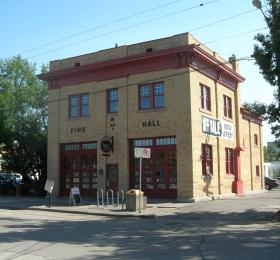Former Fire Hall No. 3
- Designated
Description of the Historic Place
The Former Fire Hall No. 3 is a two-storey, yellow brick building that was constructed in 1911. The building, located at 612 11th Street East in the neighbourhood of Nutana, features a simplistic and utilitarian style of architecture which reflects its original use as a fire hall, and later as a communications centre during the Cold War.
This historic place was designated as a Municipal Heritage Property in 1991. The designation is limited to the exterior of the building.
Heritage Value
The heritage value of Fire Hall No. 3 resides in its association with Saskatoon's boom years when the city's rapidly growing population created an increased demand for civic services. Though a fire hall already existed in Saskatoon's downtown, the population boom, combined with the decision to locate the University of Saskatchewan on the east side of the city, increased the need for a new fire hall on the east side of the South Saskatchewan River. Equipped with every modern device for its time, such as automatic overhead doors, a fireman's pole, overhead harness storage, loading pulleys, and both horse-drawn and gasoline-powered machines, this building also symbolized the progress and optimism of a growing prairie city. By 1926, the fire hall was completely motorized; it continued to serve the community until 1956 when a new fire hall was built further east.
The heritage value of Fire Hall No. 3 also resides in the building's association with the Cold War period. In 1959, at the height of the Cold War, the building became a headquarters for the Department of Civil Defence, the result of which led to alterations in the interior of the building. The basement, for example, became a radiation-proof communications centre in the event of nuclear war, an emergency food kitchen was built, and radiation-proof bricks were installed at the base of the stairs, all of which reflect the mentality of the Cold War era.
The heritage value of Fire Hall No. 3 also resides in the building's architecture, which balances a simple, functional, and utilitarian design with more elaborate elements, such as an exterior cornice and an interior molded tin ceiling. Its presence helped establish a sense of permanence in a burgeoning community and contributed to the character of the area. It is the last remaining example of Saskatoon's original fire halls and serves as a reminder of the changes that the city has undergone over the course of its history.
The building is now privately owned, and is currently used as a bar and restaurant featuring mementos from the now-demolished Capitol Theatre. Through the City’s Heritage Awards Program, the Former Fire Hall No. 3 received an award for renovation of a commercial building in 1993.
Source: City of Saskatoon Bylaw No. 7184 / City of Saskatoon Built Heritage Database / Canadian Register of Historic Places
Character Defining Elements
Key elements which contribute to the heritage value of this historic resource include:
- Those elements related to the building's original use as a fire hall, such as the fireman's pole and the original overhead doors;
- Those elements that speak to the building's use as a communications centre during the Cold War, such as the radiation-proof bricks; and
- Its basic, utilitarian design with its exterior cornice and yellow brick.

